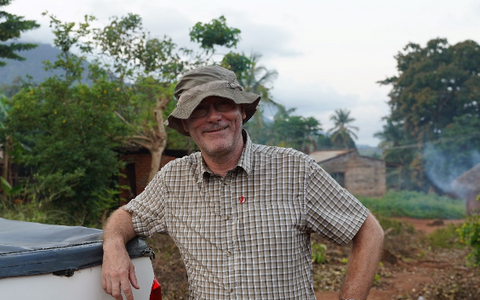
Lewin Lab
Molecular Physiology of Somatic Sensation
Group leader
Gary Lewin
Gary photographed in Potwe village, Usumbara Mountains, Tanzania. He and colleagues were working with locals to describe a new species of African mole-rat (August 2019). Picture credit: Alison Barker.
Gary is Manx and was born and grew up in Douglas on the Isle of Man. His mother is from Donegal, Ireland which means that Gary holds dual Irish and British citizenship. He received his first degree in Physiology and Pharmacology from Sheffield University in 1986, then worked on his doctoral thesis in Stephen B. McMahons lab at St. Thomas's Hospital Medical school in the Sherrington school of Physiology in London. He received his Ph.D. in February of 1990.
Gary’s doctoral work was concerned with the physiological consequences of confronting sensory neurons of the dorsal root ganglia with novel peripheral targets (Lewin and McMahon, J Neurophysiology 1991). From London he then moved to do post-doctoral work in the lab of Professor Lorne Mendell in the Department of Neurobiology and Behavior at the State University of New York at Stony Brook. He worked in Lorne's lab for almost four years and in the last year he was appointed Research Assistant Professor. A key discovery made by Gary during this time was that nerve growth factor (NGF) is a key mediator of inflammatory pain (Lewin et al., Eur J Neuro 1994; Lewin and Mendell, TINs 1993). Now more than 20 years later an antibody-based therapy developed to block endogenous NGF has been developed by Pfizer (Tanezumab, press release) and is highly effective for treating inflammatory pain in humans. At the moment Tanezumab is awaiting regulatory approval by the FDA.
In 1993 he received a Alexander von Humboldt Fellowship to work in the department of Neurobiochemistry at the Max-Planck Institute for Psychiatry in Munich under the directorship of Professor Yves-Alain Barde. Here Gary started to use mouse molecular genetics to dissect the role of neurotrophins in sensory neuron development (Lewin and Barde, Ann Rev Neuro 1996).
In February of 1996 Gary took up an appointment as an independent Group Leader at the MDC in Berlin. In 2021 the laboratory will celebrate it’s 25th anniversary. Over the last two decades the laboratory has pioneered the study of the how somatic sensory neurons transduce mechanical signals that lead to touch and pain sensation. The laboratory identified the first molecule that is necessary for normal touch, a protein called STOML3 that in turn regulates mechanosensitive ion channels like PIEZO2 (Wetzel et al., Nature 2007; Poole et al., Nature Comm. 2014; Wetzel et al., Nature Neuro 2017). In parallel to these studies the lab also established the naked mole-rat as a new model of extreme physiology. In ongoing studies, the laboratory also exploits close relatives of the naked mole-mole in Africa to understand the molecular evolution of extreme physiology (see e.g. Eigenbrod et al, Science 2019). Gary Lewin holds a joint appointment at the Charité University Medical Faculty as a full Professor. He has received various prizes and honors during his career including being awarded the Ernst Jung Prize for Medicine in 2019.


